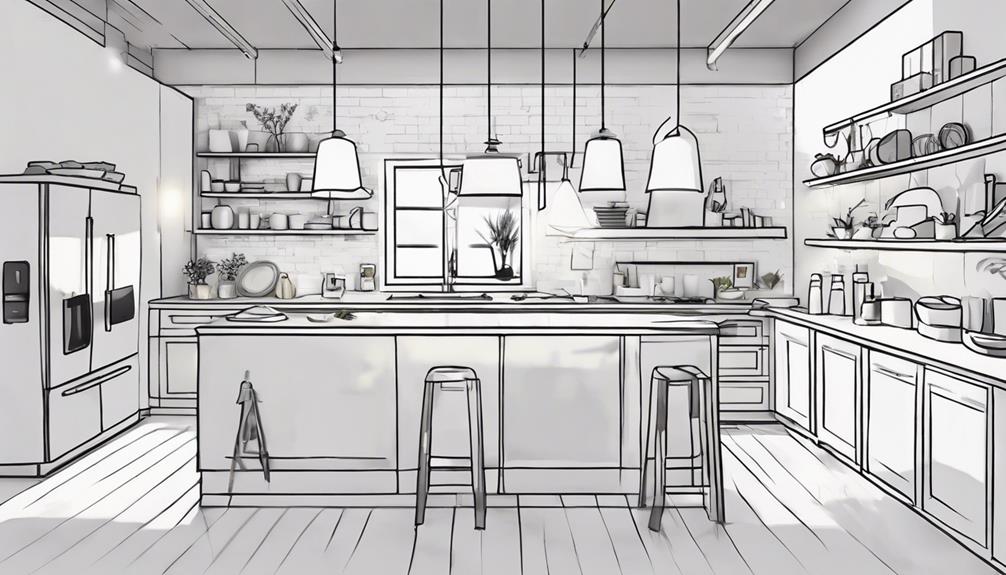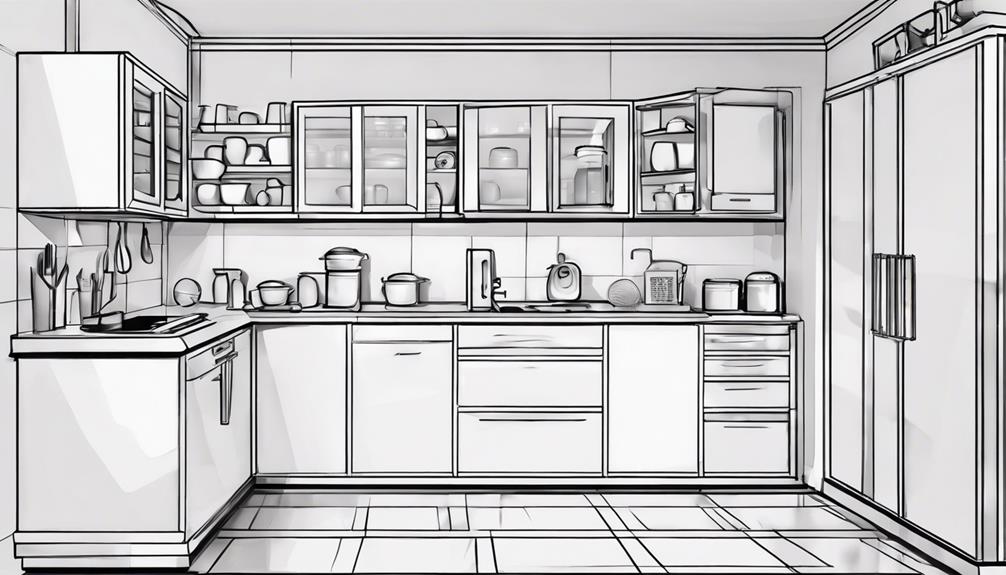Choosing the right white paint for your kitchen walls can be tough with so many options. Benjamin Moore's 'Simply White' is a favorite, but the best choice depends on your kitchen's light, size, and the color of your cabinets.
This guide will help you find the perfect white paint for a fresh, timeless kitchen look that matches your style.
Key Takeaways
- Consider 'Swiss Coffee' or 'Simply White' for versatile options in different finishes.
- Choose white shades based on lighting and desired emotions in the kitchen.
- Select white paint to complement accent colors and enhance the kitchen's aesthetic.
- Maintain white walls with gentle cleaning to preserve vibrancy and durability.
Popular White Paint Colors for Kitchens

When choosing the best white paint color for your kitchen walls, consider popular options like 'Swiss Coffee' or 'Simply White.' These shades are versatile and work well with various kitchen styles. For paint finish options, you can choose between matte, satin, or semi-gloss based on your preference. Matte finishes are great for a more subtle look, while satin and semi-gloss offer easy cleaning and durability in a kitchen setting.
As for accent wall possibilities, white provides a perfect backdrop for creating a focal point in your kitchen. You can add a pop of color with a vibrant accent wall to liven up the space or opt for a soft pastel hue for a more subtle contrast. White walls also allow you to play with textures and materials for your accent wall, such as exposed brick, shiplap, or wallpaper, adding depth and visual interest to the room. Explore different options to find the perfect balance between your white walls and accent features.
Choosing the Right Shade of White
What factors should you consider when selecting the perfect shade of white for your kitchen walls?
When choosing the right shade of white, it's important to think about color psychology and lighting effects. Color psychology plays an important role in how a color affects the mood and atmosphere of a room. White is often associated with cleanliness, purity, and spaciousness, making it a popular choice for kitchens. However, different shades of white can evoke varying emotions.
Consider the natural lighting in your kitchen. Natural light can change throughout the day, affecting how the white paint appears on your walls. A bright white might look stark and cold in a room with a lot of natural light, while a warmer white can create a cozy ambiance. On the other hand, in a kitchen with limited natural light, a brighter white can help reflect light and make the space feel more open and airy.
Factors to Consider When Selecting White Paint

To choose the best white paint for your kitchen walls, consider factors like natural lighting and the mood you want to create in the space. When selecting a white paint color, it's important to take into account the lighting considerations of your kitchen. If your kitchen receives ample natural light, you can opt for a brighter white shade to enhance the sense of openness and brightness. In contrast, if your kitchen lacks natural light, a warmer white tone can help create a cozy and inviting atmosphere.
Additionally, think about the accent colors present in your kitchen. The white paint you choose should complement these accents to create a cohesive look. For example, if you have bold-colored cabinets or countertops, a crisp white paint with cool undertones can provide a clean backdrop that allows the accents to pop. On the other hand, if your kitchen features more neutral tones, a warmer white shade can add depth and warmth to the space. By considering these factors, you can select the perfect white paint color to enhance your kitchen's overall aesthetic.
Tips for Painting Kitchen Walls White
Consider starting your painting project by preparing the kitchen walls with a thorough cleaning to guarantee the best results for applying white paint. Begin by washing the walls with a mild detergent and water solution to remove any grease, dirt, or residue. Once the walls are clean and dry, protect the areas you don't want to paint with painter's tape and drop cloths.
When it comes to painting techniques, using a high-quality paint roller can help achieve a smooth and even finish. Start by cutting in the edges with a brush and then use the roller for the larger sections. Applying two coats of white paint is usually recommended to make good coverage and a vibrant color.
For color combinations, white walls can be versatile and pair well with almost any other color in the kitchen. You can create a classic look with white cabinets and white walls for a clean and timeless aesthetic. Alternatively, consider adding pops of color through accessories like curtains, rugs, or kitchen appliances to complement the white walls.
Maintenance and Durability of White Paint

Guaranteeing proper maintenance and durability of white paint on kitchen walls is crucial for preserving the fresh and clean appearance of the space. White paint can brighten up your kitchen, but it demands attention to maintain its longevity.
To keep your white walls looking pristine, adopt gentle cleaning techniques. Avoid harsh chemicals that can strip the paint or cause discoloration. Instead, opt for mild soapy water and a soft sponge to gently clean any stains or marks. Regularly dusting the walls can also prevent grime buildup and maintain the paint's vibrancy.
When dealing with tougher stains, consider using a baking soda paste as a natural and effective cleaning solution. Additionally, promptly address any scuff marks or scratches to prevent them from becoming more prominent over time.
Final Thoughts on White Kitchen Walls
Maintaining the cleanliness and vibrancy of your white kitchen walls will guarantee a lasting appeal that enhances the overall aesthetic of your space. When it comes to color psychology, white is known to evoke feelings of cleanliness, purity, and spaciousness, making it an ideal choice for kitchen walls. The crisp and bright nature of white can also create a sense of freshness and modernity in your kitchen, setting the perfect backdrop for your culinary adventures.
Consider the lighting effects in your kitchen when choosing a white paint color. Natural light can accentuate the brightness of white walls, while essential lighting can play a vital role in creating ambiance and highlighting specific design elements. Warm lighting can soften the starkness of white, creating a cozy atmosphere, while cool lighting can enhance the clean and contemporary look of your kitchen.
Conclusion
Selecting the perfect white paint, like Simply White or Chantilly Lace, transforms a kitchen into a bright and welcoming space. It's essential to consider the unique interplay of light and decor in your kitchen to ensure the walls complement the room's overall aesthetic.
Preparation and choosing a finish that combines durability with ease of cleaning will guarantee your kitchen's walls maintain their beauty for years. This choice not only rejuvenates the heart of the home but also raises the question: what other simple changes can similarly uplift our living spaces?

